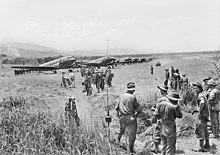2/16th Battalion (Australia)
| 2/16th Battalion | |
|---|---|
 Troops from the 2/16th fly in to Kaiapit, September 1943 | |
| Active | April 1940 – February 1946 |
| Country | Australia |
| Branch | Australian Army |
| Type | Infantry |
| Size | ~ 800–900 personnel all ranks[1] |
| Part of | 21st Brigade, 7th Division |
| Colours | White over blue |
| Engagements | World War II |
| Insignia | |
Unit colour patch |  |
The 2/16th Battalion was an
History
Formation and service in the Middle East
The 2/16th Battalion was recruited in
The unit conducted its own basic training, which was only partially completed prior to its embarkation for Egypt in October 1940. The battalion's first commanding officer was Lieutenant Colonel
Sailing via India, the 21st Brigade briefly landed at
Syria-Lebanon Campaign
In April 1941, the battalion was transported back to Palestine to take part in Operation Exporter, which was the Allied codename for the
New Guinea Campaigns
By early 1942, the Japanese had entered the war, and the Australian government decided to bring some of its troops from the Middle East back to Australia to bolster its defences. The 2/16th embarked at the end of January 1942, and returned to Australia, landing at

As the tide of the campaign along the Kokoda Track turned towards the Australians, the Japanese withdrew north towards their beachheads around Buna and Gona, with the Australians in pursuit. A brief period of rest and reorganisation followed for the 2/16th during this time, as they were re-constituted before being committed to the Battle of Buna–Gona in November 1942. Despite the arrival of reinforcements, the battalion could only provide two or its four rifle companies to the fighting, and by early January it was withdrawn, with a strength of only 56 men.[2]
The battalion was subsequently rebuilt on the
Borneo and disbandment
After returning to Australia, the battalion spent over a year training for its final campaign – the
Throughout its service a total of 3,275 men served with the battalion
Battle honours
The 2/16th Battalion received 21
- North Africa, Syria 1941, Syrian Frontier, The Litani, Wadi Zeini, Damour, South-West Pacific 1942–1945, Kokoda Trail, Isurava, Eora Creek–Templeton's Crossing I, Efogi–Menari, Ioribaiwa, Buna–Gona, Gona, Amboga River, Lae–Nadzab, Liberation of Australian New Guinea, Ramu Valley, Shaggy Ridge, Borneo 1945, Balikpapan.[2]
These honours were subsequently entrusted to the
Commanding officers
The following officers served as commanding officer of the 2/16th Battalion:[9][21]
- Lieutenant Colonel Alfred Richard Baxter-Cox (1940–41)
- Lieutenant Colonel Alex Bath MacDonald (1941)
- Lieutenant Colonel Arnold Potts (1941–42)
- Lieutenant Colonel Albert Edward Caro (1942)
- Lieutenant Colonel Frank Henry Sublet (1943–45).
Notes
- ^ The establishment of a standard Australian infantry battalion was 35 officers and 875 other ranks at the start of the Second World War. Under the jungle organisation each battalion was reduced by one officer and 106 other ranks. See Kuring 2004, p. 47 and Palazzo 2004, p.94.
- ^ a b c d e f g h i j k l m n o p q "2/16th Battalion". Second World War, 1939–1945 units. Australian War Memorial. Archived from the original on 15 March 2011. Retrieved 15 November 2009.
- ^ Grey 2008, p. 146.
- ^ Palazzo 2004, p. 94.
- ^ Long 1952, p. 52.
- ^ "AWM52 8/3/16/1: April – July 1940". Unit War Diaries. Australian War Memorial. Retrieved 28 September 2014.
- ^ Long 1952, pp. 321–323.
- ^ Burns 1960, p. 23.
- ^ a b c d e Pratten 2009, p. 325.
- ^ a b "16th Battalion, Royal West Australian Regiment". Department of Defence. Archived from the original on 29 September 2008. Retrieved 9 November 2008.
- ^ James 2017, p. 165.
- ^ Keogh 1965, pp. 127–132.
- ^ Brune 2004, p. 143.
- ^ Brune 2004, p. 236.
- ^ Bradley 2004a, p. 148.
- ^ Bradley 2004b, pp. 22–27.
- ^ Keogh 1965, pp. 457–460.
- ^ Johnston 2005, p. 248.
- ^ Festberg 1972, p. 77.
- ^ Festberg 1972, p. 32.
- ^ Johnston 2005, p. xiv.
References
- ISBN 0-19-555100-1.
- Bradley, Phillip (2004b). "Assault on the Pimple". Wartime (28 (October)). Canberra, Australian War Memorial: Australian War Memorial: 22–27. ISSN 1328-2727.
- Brune, Peter (2004). A Bastard of a Place: The Australians in Papua – Kokoda, Milne Bay, Gona, Buna, Sanananda. Crows Nest, New South Wales: Allen & Unwin. ISBN 978-1-74114-403-1.
- Burns, John (1960). The Brown and Blue Diamond at War: The Story of the 2/27th Battalion A.I.F. Adelaide, South Australia: 2/27th Battalion Ex-servicemen's Association. OCLC 2104460.
- Festberg, Alfred (1972). The Lineage of the Australian Army. Melbourne, Victoria: Allara Publishing. ISBN 978-0-85887-024-6.
- ISBN 978-0-521-69791-0.
- James, Richard (2017). Australia's War with France: The Campaign in Syria and Lebanon, 1941. Newport, New South Wales: Big Sky Publishing. ISBN 978-1-925520-92-7.
- ISBN 1-74114-191-5.
- OCLC 7185705.
- Kuring, Ian (2004). Redcoats to Cams: A History of Australian Infantry 1788–2001. Loftus, New South Wales: Australian Military History Publications. ISBN 1-876439-99-8.
- OCLC 18400892.
- Palazzo, Albert (2004). "Organising for Jungle Warfare". In Dennis, Peter; Grey, Jeffrey (eds.). The Foundations of Victory: The Pacific War 1943–1944. Canberra, Australian Capital Territory: Army History Unit. pp. 86–102. ISBN 978-0-646-43590-9. Archived from the originalon 9 March 2016.
- ISBN 978-0-521-76345-5.
Further reading
- OCLC 6213478.
